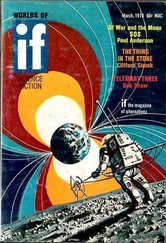“All of us probably haven’t got it,” Monk reminded him. “It would be more pronounced in some of us than others.”
“We’ll find the ones who have it,” declared Chambers. “We’ll place them in key positions. The psychologists will develop tests for it. We’ll see if we can’t improve it, develop it. Help it along.
“You have it, Monk. It saved you when the asterites tried to get you that night in Sandebar. Something told you to heave that jewel against the manuscript case. You did it, instinctively, wondering why. You said that afterward you even speculated on why you did it, couldn’t find an answer. And yet it was the proper thing to do.
“Findlay out on Pluto has it. Calls it a feeling for the future, the ability to look just a little ways ahead. That looking just a ways ahead will help us keep one jump beyond our problems.
“Allen has it. He investigated Sanctuary on a hunch, even felt ashamed of himself for doing it, but he went ahead and played his hunch.”
“Just a second, chief,” Allen interrupted. “Before you go any further there’s something to be done. We got to go out and bring in Hannibal. Even if it takes the whole fleet—”
“There’s no use,” said Chambers.
He rose and faced them.
“Hannibal,” he said, “died half an hour ago. They killed him.”
Slowly he walked around the desk, felt his way across the room toward the window. Once he stumbled on a rug, once he ran into a chair.
“Construction Shack,” certainly one of the subcategory of Simak stories that might be called “sense of wonder” stories, first appeared in the January-February 1973 issue of Worlds of If , and it was regarded as a contender for a Hugo Award.
This is the second Simak story to feature a smooth, metal planet (see “Limiting Factor,” which will appear in volume 14 of these collections). It also features the line “No one would be mad enough to postulate a gang of cosmic engineers who went about the universe …”— Was it coincidence that in 1972 Cliff Simak would again find use for the title of his first novel, Cosmic Engineers ?
—dww
In that same year when men first walked on Mars the probe was launched from the moon for Pluto. Five years later the first pictures were transmitted as the orbiting probe trained its cameras on the planet’s surface. The transmission quality was poor; but even so, certain features of the photographs were productive of great anguish as old theories fell to shards and were replaced by puzzlement, questions with no hint of answers. The pictures seemed to say that the planet had a smooth, almost polished surface, without a single geographic feature to break the smoothness of it. Except that at certain places, equidistant from one another along the equator, were tiny dots that would have been taken for transmission noise if they had not appeared consistently. Too, the dots still persisted when some of the noise was eliminated. So it seemed they must be small geographic features or shadows cast by geographic features, although at Pluto’s distance from the sun shadows would be suspect. The other data did nothing to lessen the anguish. The planet was smaller than supposed, less than a thousand miles in diameter, and its density worked out to 3.5 grams per cubic centimeter rather than the unrealistic figure of 60 grams, previously supposed.
This meant several things. It meant that somewhere out there, perhaps something more than seven billion miles from the sun, a tenth planet of the solar system swung in orbit, for no planet the size and mass of Pluto could explain the eccentricities in the orbits of Uranus and Neptune. The calculation of Pluto’s mass, now proved inaccurate, had been based on the measurement of those eccentricities and it must be admitted now that something else must account for them.
Beyond that, Pluto was most strange—a smooth planet, featureless except for the evenly spaced dots. The smoothness certainly could not be explained by a non-turbulent atmosphere, for surely Pluto had to be too small and cold to hold an atmosphere. A surface of ice, men wondered, the frozen remnants of a one-time, momentary atmosphere? But for a number of reasons that didn’t seem right, either. Metal, perhaps, but if the planet were of solid metal the density should be far greater.
The men on Earth consoled themselves. In five more years the probe would come back to Earth, carrying with it the films that it had taken and from them, the actual films and not the low-quality transmissions, perhaps much that was hazy now might become understandable. The probe swung in its measured orbits and sent back more pictures, although they were little help, for the quality still was poor. Then it fired the automatic sequence that would head it back to Earth, and its beeping signals from far out in space said it was headed home on a true and steady course.
Something happened. The beeping stopped and there was silence. Moon base waited. It might start up again. The silence might indicate only a momentary malfunction and the signals might start again. But they never did. Somewhere, some three billion miles from the sun, some mishap had befallen the homing probe. It was never heard again—it was lost forever.
There was no sense in sending out another probe until a day when technical advances could assure better pictures. The technical advances would have to be significant—small refinements would do little good.
The second and third manned expeditions went to Mars and came home again, bringing back, among many other things, evidence that primitive forms of life existed there, which settled once for all the old, dark suspicion that life might be an aberration to be found only on the Earth. For with life on two planets in the same solar system there could no longer be any doubt that life was a common factor in the universe. The fourth expedition went out, landed and did not come back again and now there was on Mars a piece of ground that was forever Earth. The fifth expedition was sent out even while the Earth still paid tribute to those four men who had died so far from home.
Now that life had been found on another world, now that it was apparent that another planet at one time had held seas and rivers and an atmosphere that had been an approximation of Earth’s own atmosphere, now that we knew we no longer were alone in the universe, the public interest and support of space travel revived. Scientists, remembering (never having, in fact, forgotten, for it had gnawed steadily at their minds) the puzzlement of the Pluto probe, began to plan a manned Pluto expedition, as there was still no sense in sending an instrumented probe.
When the day came to lift from the Moon Base, I was a member of the expedition. I went along as a geologist—the last thing a Pluto expedition needed.
There were three of us and any psychologist will tell you that three is a number that is most unfortunate. Two gang up on one or ignore one and there is always competition to be one of the gang of two. No one wants to stand alone with the other two against him. But it didn’t work that way with us. We got along all right, although there were times when it was rough going. The five years that the probe took to arrive at Pluto was cut by more than half, not only because of improved rocket capability, but because a manned craft could pile on velocity that couldn’t be programed—or at least safely programed—into a probe. But a bit more than two years is a long time to be cooped up in a tin can rocketing along in emptiness. Maybe it wouldn’t be so bad if you had some sense of speed, of really getting somewhere—but you haven’t. You just hang there in space.
The three of us? Well, I am Howard Hunt and the other two were Orson Gates, a chemist, and Tyler Hampton, an engineer.
Читать дальше












